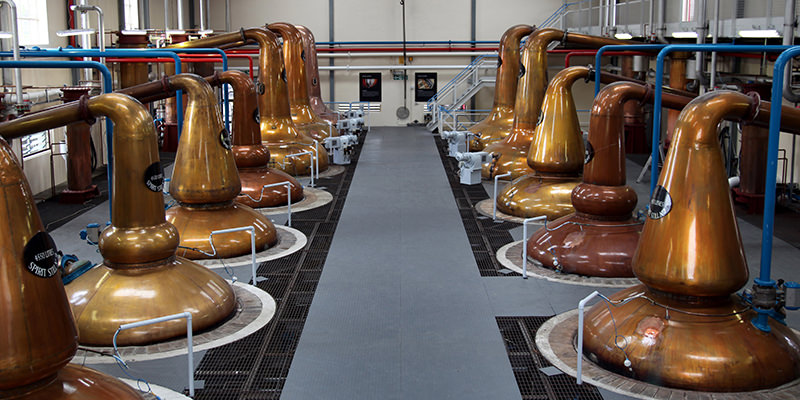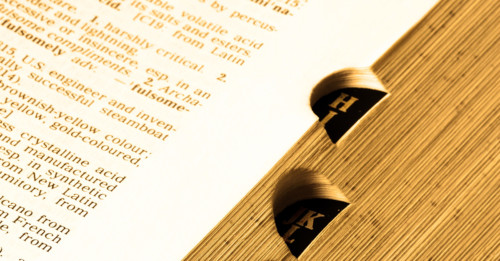For a list of most of the spirits you’ll actually encounter in your liquor store, head over here. But the list doesn’t stop there—here are some terms directly related to the production or consumption of the hard stuff.
Distilling Terms
Distillation: The process of separating the elements of a liquid—e.g., ethanol from water—using evaporation and condensation. Ethanol evaporates at 173 F, versus water at 212 F.
Mash/Wash/Wine: Terms used to describe the fermented liquid—grain-based or fruit- or vegetable-derived—being distilled. Wines are fruit-based, distilled into brandy.
Proof: A historic term still in use today, referring to twice the alcohol by volume of a spirit, e.g. a 40% ABV whiskey would be 80 proof. (Though “proof” systems are not the same in the UK as the US.) Overproof of Navy Strength means the spirit—usually rum or gin—has an ABV of 57% or higher.
Pot Distilling: Using a pot (or alembic) still to distill a wine or wash one batch at a time, with the alcohol evaporated into a tube or “lyne arm” and condensed back into liquid. The earliest form of distilling, more labor-intensive, pot distilling results in a spirit with more “congeners.”
Column Distilling: Distilling using a column-based system into which the wash is continuously pumped into the column, where rising steam strips away the ethanol. Results in a purer, less flavored, higher ABV spirit.
Congeners: More or less desirable flavoring compounds that evaporate with the ethanol as part of the distilling process. Found in greater quantity in darker spirits (as well as darker wines), at best they can contribute to the distinctive character of a spirit. They are also contributors to hangovers.
Barrel or Cask-Aging: Aging the product of distillation in a wooden (often oak) barrel or cask that may or may not have been previously used to age another spirit, and may or may not have been charred to blacken the inside. The aging process mellows some of the harshness of the spirit while also infusing it with both color and character from the wood itself.
Barrel Proof/Cask Strength: Terms found on the label of a whiskey bottle, indicating the spirit was not diluted once it was removed from the barrel or cask, meaning it is much higher proof than the spirit traditionally. (Cask Strength Laphroiag 10 Year would be higher than traditional Laphroiag 10 Year.)
Infusion: The process of infusing a finished spirit with an added flavor, usually by putting the desired ingredient (fruit, vegetable, spice) directly into the spirit and letting it steep for a specific period of time (certain ingredients become dangerous after steeping too long). More often done with lighter spirits, where the flavor will be more perceptible.
Spirits Serving Terms
Neat: How you would order a spirit if you wanted it served entirely by itself—no ice, no mixers, no chilling even. Just a simple pour of the spirit into the glass.
Straight Up/Up: A slightly confusing term, not to be confused with “neat,” it means a spirit or mixed drink that’s been chilled but served without ice.
On the Rocks: The classic way to order a spirit if you want it poured over some ice cubes.
Finger: Most people don’t order “three fingers of gin” these days, but in case you’re in the mood to sound old timey, this one just means the amount of liquid to pour up to the level of your fingers when they’re laced around the glass. One finger, two fingers, three fingers—a fist, etc.
Twist: Ordering something “with a twist” means a twist of citrus peel—by default, lemon—will be applied to the drink.
Cocktail: A name given to the historic mixture of spirits, sugar, water, and bitters, but since evolved to refer colloquially to any kind of spirits-based mixed drink.
Mocktail: A recent innovation, done after the style of the cocktail except entirely alcohol-free.
Virgin: Meaning a mixed drink that forgoes the alcohol, e.g. a Virgin Daiquiri.
Well Drink: Meaning the cocktail is used with a “well” spirit, which is to say the house liquor—as with house wine, it’s whatever brand the bar or restaurant keeps as its basic liquor, usually (but not always) a cheaper variety.
Shaken vs. Stirred: Most drinks are prepared by mixing the ingredients with ice (and then either straining or keeping the ice). Shaken drinks are shaken with ice, resulting in some added aeration and dilution (good for citrusy drinks) while stirred drinks are stirred with ice, with a resulting smoother mouthfeel (good for dark or strong drinks).
Dirty: A drink, typically a Martini, prepared with the addition of some olive brine, lending a bit of salt and acidic tang to the finished product.
Dry: Again used often in connection with the Martini, where it means less Vermouth is added (so the final drink is less sweet). Can also be used as a way to order a drink with less of any sugary additive.
Shooter vs. Shot: A shot is just a small pour of a straight spirit. A shooter is a mixed drink, spirit plus any other flavorings, served in a shot glass.
Chaser vs. Back: A “back” is something you drink alongside your straight spirit, e.g. soda or water. A “chaser” is something slightly more palatable meant to follow a shot of straight hooch.

And Just Because They’re Confusing — Whiskey Terms
Malt Whiskey: Whiskey that is made entirely from malted barley, with no other added grains.
Grain Whisky: Whiskey made from a proportion of other grains (e.g. corn, rye) in addition to (or instead of) malted barley.
Corn Whiskey: A whiskey made from a mash containing 80% minimum corn.
Blended Whiskey: Malt whiskey combined with grain whiskey, with a legal minimum of 40% malt whiskey.
Single Malt Scotch Whisky: Refers to a Malt Whiskey that’s made by one distillery.
Single Grain Scotch Whisky: Refers to a Grain Whiskey that’s made by one distillery (the “single” in both cases refers to the distillery).
Single Cask/Single Barrel Whiskey: A whiskey that’s bottled from the product of one cask or barrel, that is, with no blending between barrels, meaning inconsistencies will be more noticeable (and often more prized).
Tennessee Whiskey: An “almost” bourbon—technically, but not spiritually, a bourbon—made almost entirely the way Bourbon is made except the final product is filtered through maple charcoal (known as the Lincoln County Process), which has the effect of further “smoothing” out the whiskey and, supposedly, influencing the flavor of the finished product.
Bourbon: A 51% corn-based whiskey that’s distilled to no more than 80% ABV and aged in new, charred white oak barrels at no higher than 62.5% ABV
Peated: A term you might see on a Scotch whisky bottle, indicating the malted barley has been dried over a peat fire and the finished product will have a distinctive smokiness.
